
If you’ve followed any of my writing, you know I’m a shotgun nerd. I ran across the Winchester Model 1911 SL shotgun when I was doing some research into firearms I consider dangerous to the shooter. Nicknamed the Widowmaker, this shotgun is a very early example of a semi-auto shotgun. The Winchester Model 1911 SL was designed by a man named T.C. Johnson, and he had the assignment of designing a gun around John Browning’s Auto 5 patent.
One of those patent included the idea of a charging handle attached to the bolt. So T.C. Johnson had to develop an auto-loading shotgun that didn’t violate Browning’s patent. Johnson was a brilliant designer, and he gave us one of the best shotguns ever made, the Model 12. It still took him ten years to develop the Winchester Model 1911 SL.
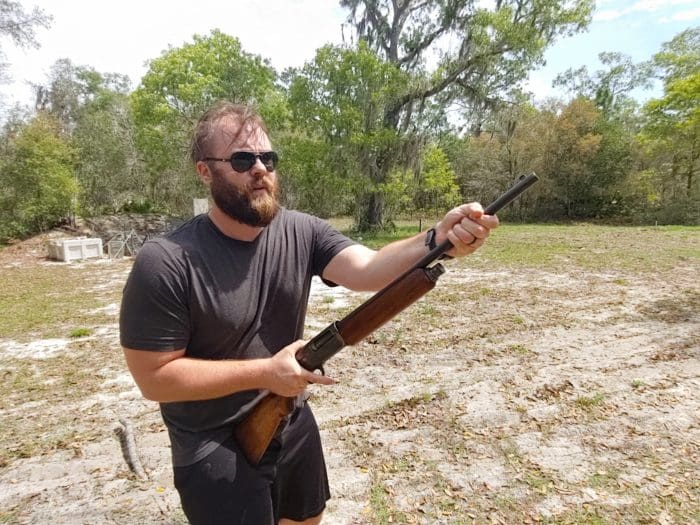
Designing around the Browning patent required some creative problem solving, and in many ways, it’s a great example of why sometimes thinking out of the box…doesn’t work. Still, when I came across one in a pawn shop, I had to have it. It’s an interesting part of history, and only about 80,000 Winchester 1911 SL shotguns were built before Winchester ended production.
The Winchester Model 1911 SL In Real Life
The Winchester Model 1911 SL uses the long recoil system that was popular with semi-auto platforms. Long recoil involves the barrel and bolt moving rearward together for a short period before the barrel stops, and the bolt continues to move. A coiled spring throws the barrel back forward, and a mainspring allows the bolt to close.
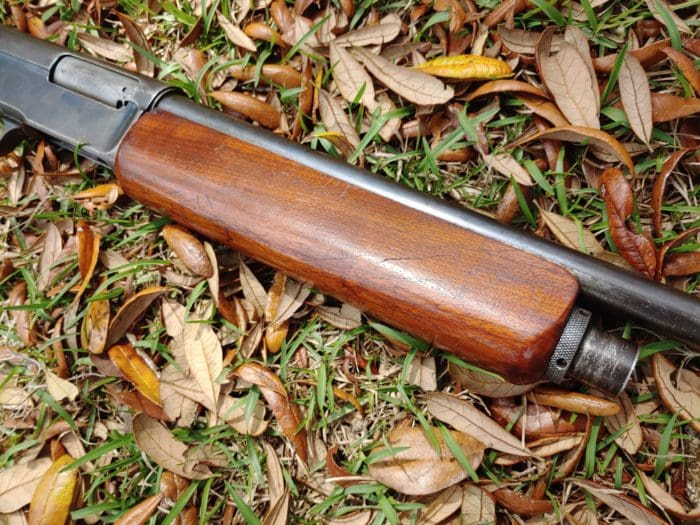
One of the features of the Winchester 1911 SL brought to shotguns — and guns in general — was the use of laminated furniture. This was necessary to prevent the stocks from cracking and breaking under recoil. One of Browning’s other patents was metal recoil rings, so Winchester used fibrous rings. These rings, however, wore out quickly and deteriorated and would often deliver a harsher recoil impulse the more they were worn.
The Winchester 1911 SL came in popular shotgun calibers, including 12, 20, 16, and 28 gauge. My shotgun is the 12 gauge model. The gun only chambers 2.75-inch shells and the magazine fits five of them in its tubular magazine. Barrel lengths were either 26 or 28 inches, and the scattergun weighs about eight pounds.
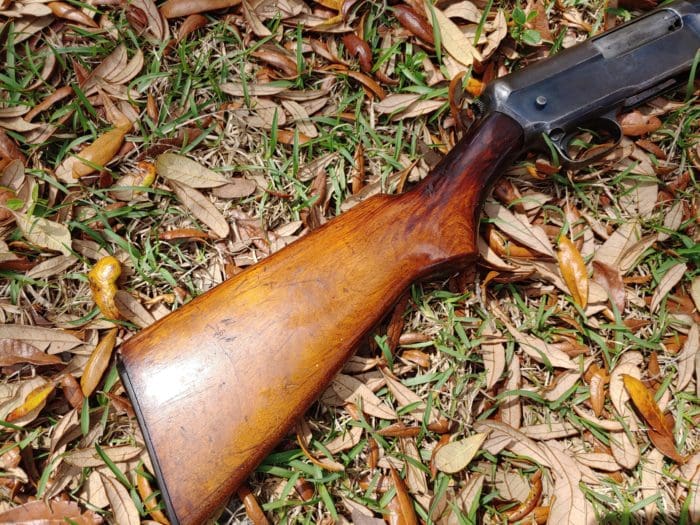
The Model 1911 SL features a bolt hold open that the shooter manually activates. Press the button on the rear of the receiver and the bolt will lock back after every shot if you so choose. There’s also a manual safety behind the trigger.
Take-down weapons were very popular, and this gun features an unusual takedown design. The receiver and barrel stay together, and separate from the trigger and stock when separated. It pops right into a modern AR15 case without issue.
What I’m Leaving Out
I mentioned that Browning patented charging handles and that this gun was built around the Auto 5 patent. So what was the solution Winchester and T.C. Johnson came up with? They knurled a section of the barrel of the Model 1911 SL heavily. The shooter had to grip the barrel and pull it rearwards to cock the gun.

This system is easily the least ergonomic option I’ve ever seen and is why the gun has a reputation for being dangerous. The Widowmaker’s name comes from the fact that many shooters would brace the gun against the ground and work the barrel while leaning over it. I’m not sure if this ever happened, but it’s not like records from 1911 to 1925 are easy to find over google documenting such an event.
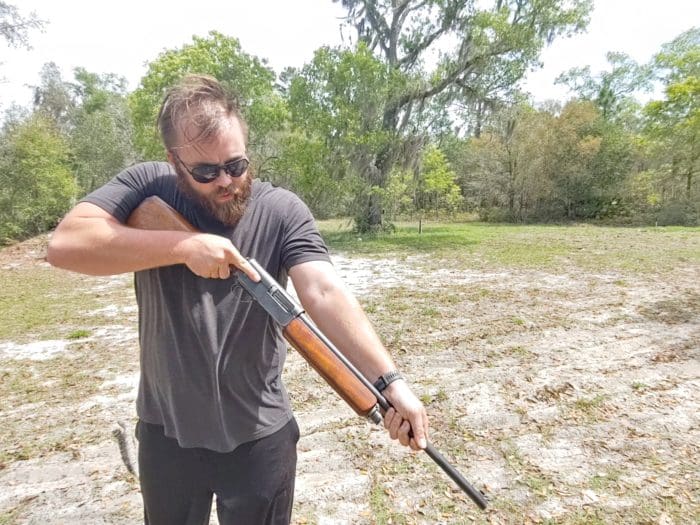
The real danger comes from pointing the weapon in a safe direction while trying to cock and charge the weapon or to clear a malfunction. I have big, long arms and it’s awkward for me to try and point the weapon down while I pull the barrel to the rear. If you were a shorter shooter, it would create an interesting challenge. And it it was probably why many shooters put the gun on the ground and tried to charge it vertically.
Going Live
The barrel cocking system makes it quite an ergonomic mess. A hot barrel doesn’t make the process any better. The safest way to cock and charge this shotgun is to lock the bolt to the rear, load a round into the chamber, close the chamber, and then load the magazine.
When you get to the fifth and final round, it will behoove you to press the bolt lock button at the rear of the receiver. That way, when the gun fires the last round in the magazine, the bolt will lock to the rear and you can reload without having to grab a hot barrel.
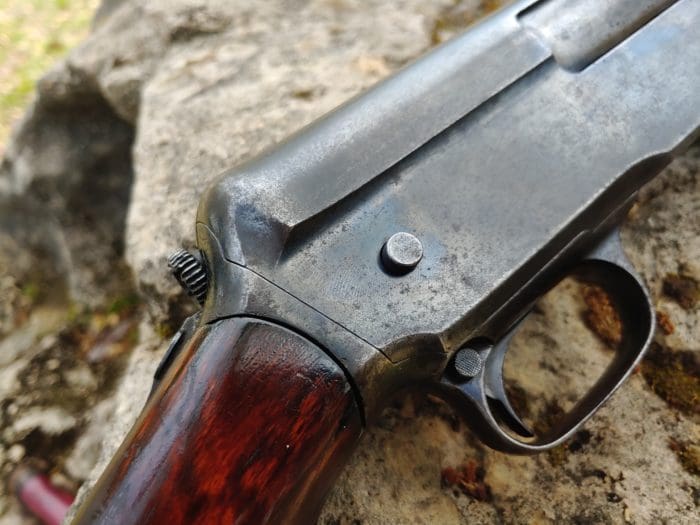
The recoil rings are worn out in mine, and that’s evident from the gun’s sharp recoil. I only shoot light loads from the gun, and they deliver a fairly sharp slap for a semi-auto firing cheap game loads.
The Winchester Model 1911 SL isn’t a firearm I shoot a lot, but it seems to be fairly reliable. I’ve had a few failures to eject, which create an interesting situation if the barrel is hot (pro tip: if you own one of these, keep an oven mitt or welding glove in your range bag).
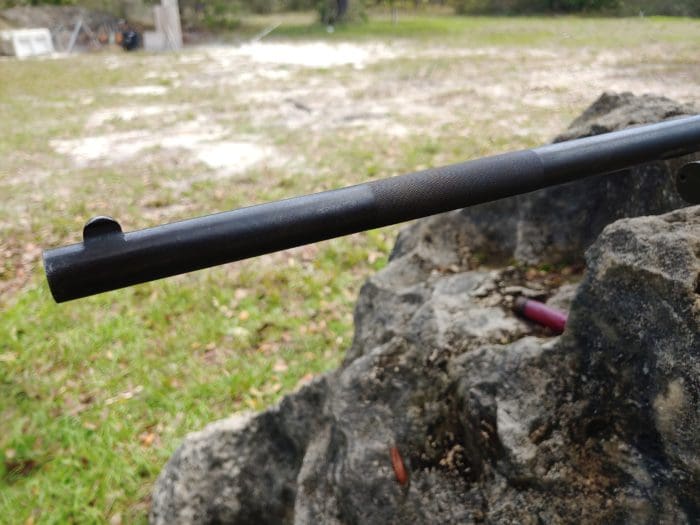
The front sight blade is interesting. It looks like a standard blade, but when you shoulder the gun, it looks like a bead. Placing the sight a little higher over the barrel makes the point of aim and point of impact equal. A bead too low on the barrel gives the shotgun the appearance of shooting high. It’s plenty accurate and swings well, although I won’t take it to the trap range.
So Why Is This Thing Desirable?
The Model 1911 SL doesn’t seem like a shotgun anyone would really want. If the firearm was released today, it would be laughed out of the industry. However, seeing as how it’s a hundred years old, there is certainly an interesting historical factor to the weapon. For me, it’s desirable because it’s weird, and because it’s a shotgun, which are two things I’m already partial to.
It’s also the product of the Browning and Winchester breakup, which is its own deep and often misunderstood story. The Winchester Model 1911 SL has one funky feature that ultimately made the design undesirable for most shooters. Add a charging handle to this thing and maybe some metal rings, and you’d have an American classic.
However, I prefer the weirdness. It makes for a much better story.
Where To Buy





Never heard of this gun. That barrel charging device must have been even more awkward a 100 years ago. Americans were, on average, a little smaller and certainly slighter of stature then.
A buddy has one of the poorly made newer 870’s. At least once a hunt or shooting session he has to mortar that thing to make it work. I cringe every time he does so. But he’s tight as the bark on a tree and refuses to move on and get a more reliable gun.
Good write up. I’ve shot a number of these and wasn’t aware it was made in any gauge other than 12. If one had a 28 ga, that’d really be rare.
More weird than this is the old Mossberg pump made on what must’ve been their 3 shot bolt shotgun base, including the stock and modified receiver pattern. Black plastic fore end to shuck. I’ve had many chances to purchase these over the past 60 years or so, never bit but at some point I’ll probably see one after several beers or something.
Hey! I have one of these in 12ga. Been sitting in the safe. Its got some scratches and dings but nothing too bad, the finish shows some signs of wear. Apparently though it had been fired because there was residue inside when I got it. The end of the barrel shows signs of having been rubbed/pushed against something frequently enough to cause the wear, perhaps against a wall or something to avoid a “widow maker” event when the barrel was pushed in. Got it many years ago from an estate sale.
The buffer rings (which are basically two fiber washers) are missing from it having broken apart I think because I found a piece of one of them inside the gun when I took it apart. Apparently the original owner was (maybe) intending to replace these at one point but passed away before he did or just decided not to and maybe just leave it for another time, the box it was in had what looks like two “new” buffer rings but I’m not going to put them in, and they do not look to be in the best of shape anyway.
Its an interesting piece of firearms history though, and I like it just fine for that purpose.
My uncle had one, his son probably has it now.
Cant ever remembering him shooting it.
Great research and write up. I didn’t know shotgun auto loaders went back that far. I do have a question. With so many shot/slug guns on the market I want to turn in my side by side Savage and Marlin 12 Ga deerslayer in for a all around gun capable of all size shells and needs. I been thinking about the Mossberg M500. I would appreciate your opionon as I respect your knowlegde and background.
But at the time semi-auto shotguns cycled so slowly a pump-action shotgun was often faster to fire.
“The gun only chambers 2.75-inch shells and the magazine fits five of them in its tubular magazine.”
Except in Hollywood movies, where every shotgun can fire ten, fifteen, even twenty shells without reloading!
roll some header wrap on that knurling.
An important point to mention has to do with fact that shotshells were paper at the time. Dislodging wet shells from the gun in a duck blind was a relatively common occurrence that was certainly more problematic with this weapon.
A High school friend had one of these and an 11-48.
I love recoil shotguns….. I guess it make me think of an artillery piece.
Anyway, we had a lot of fun shooting it, I much prefer it to an Auto 5. I never cared for the hump.
We thought it was pretty dangerous to shoot skeet with…….but we were careful and did it anyway. His was reliable with cheap skeet loads.
I preferred the 1148 to winchester and still love me 11-48.
Nice article and memory inducer.
And you don’t try to cock it at the shoulder ….. drop the stock below and behind your ahoulder with the barrel pointed down range to shuck it.
Trying to charge it at the shoulder was a non starter for us less than 6 foot.
THANKS ON HISTORY
I think you just described the short recoil system:
“Long recoil involves the barrel and bolt moving rearward together for a short period before the barrel stops, and the bolt continues to move. A coiled spring throws the barrel back forward, and a mainspring allows the bolt to close.”
My understanding of the long recoil system is that the barrel and bolt recoil all the way back until the bolt stops at its rearward limit of travel and then the barrel returns under spring pressure, followed by the bolt after it strips another round out of the magazine.
Still it was a good article. I’ve seen several of these on the used racks of gun shops over the years.
I have mentioned this shotgun in comments here at TTAG going back years. It is an embarrassment of human factors design.
You mention the slap from fairly light loads. The gun’s other nickname was “Skull Cracker,” from the way it would recoil up into your face with game loads. The Browning patents also covered the recoil slip rings used in the A5’s recoil system. The Winchester 1911 had a couple of compressed cloth discs that were “end of stroke” recoil buffers, but they didn’t absorb much recoil. When the barrel reached the full rearwards point of travel, the recoil impulse into the shooter was vicious.
If someone wants to collect one of these things to hang on the wall, go for it. Actually shooting them should be done with only light loads and then only for amusement. They’re a horrible design in so many ways…
Save your money and buy a nice Model 12 instead.
I had an online auction bid recently on one of these 1911SL’s. I was disappointed when I lost. I liked the history and weirdness of the gun, not unlike auto buffs who like the EDSEL maybe. Thanks for the nice write up on this oddball from a century ago!
Why oh why didn’t they just put a lever on the receiver that pushed the barrel in?
I’ve got one…it’s a family heirloom….it’s 112yrs old.
Was my great-great Grandfather’s…he bought it brand new in New Orleans in 1912.
My dad and my uncle used it for duck hunting back in the 60s & 70s and hasn’t been used at least since 1972 or 1974.
Comments are closed.